Forgotten Heroes - The Muslim Contribution
Issue 62 November 2009
With Remembrance Day today, Somaiya Khan-Piachaud and Ayman Khwaja remember the sacrifice of Muslim soldiers, who gave their lives and their limbs in the name of duty in both the first and second World Wars.
(This feature was first published in Issue 62, November 2009)
Inscribed in stone, along with tens of thousands of other missing war dead, are the names of Muhammad Aslam, Abdullah Khan, Ahmad Khan and Muhammad Usman. Visit the Menin Gate at Ypres in Belgium and you will see these and numerous other obviously Muslim names on the memorial that is dedicated to the commemoration of soldiers killed in the Ypres Salient of the First World War, whose resting places are unknown. It is a large Hall of Memory, honouring 54,896 British and Commonwealth soldiers who could not be buried, their names cut into vast panels.
The marble in Ypres that bear these names will endure, but they remain cold and silent. As a country – and as Muslims in particular – we have failed to ÿ honour the memory of those who fought to protect the freedoms we enjoy today. The memorial in Ypres testifies to the service of Muslim soldiers but we, their descendants and their debtors, have neglected to remember the scope of their sacrifice.
Certainly, the time is ripe to acknowledge this: too many of us are either unfamiliar with the fact that Muslims too had been embroiled in the “war to end all wars”, or lack an understanding of their contributions. Military historian Major Gordon Corrigan says the role of the British Indian Army was vital to the war effort; had they not helped fortify the front line during the First World War the Germans might well have broken through and made it to the ports on the English Channel. “The Punjabi Musselman was regarded as the backbone of the old Indian army, and constituted about a third of the British Indian Army. Known for their reliability, they were steady men who could be depended on to carry out any task at hand.”
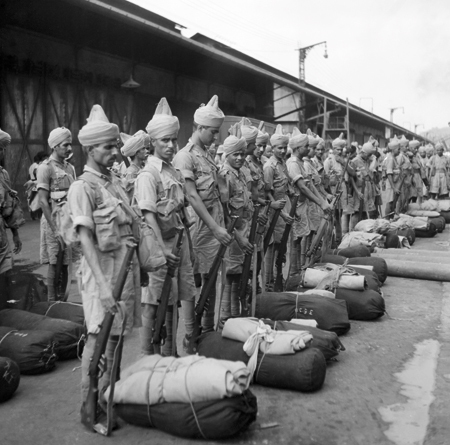
Newly-arrived Indian troops parade on the quayside at Singapore, November, 1941.
And so when they were needed most, in September 1914 — only a month after the outbreak of the war—two divisions of infantry and cavalry of the Indian Army journeyed across a continent to give some hope and relief to the Allies battling on the Western Front. Even at this early stage, the Allied forces had already suffered huge casualties, and so reinforcements were an urgent necessity to plug holes in the British defensive line. The role of the sepoys (Indian soldiers serving under British command) in filling the gaps was crucial; and all the more remarkable considering they were far from home and plunged into the full horror of trench warfare in Europe’s bloodiest of wars.
Of the 1.3 million Indians who constituted the volunteer force during the First World War, approximately 400,000 were Muslims. Historians put numbers of Indians close to 50,000 injured and 8,500 dead on the Western Front (France and Belgium). An estimated third to a half of these war-dead were Muslims, who fought and died alongside their fellow Hindu and Sikh countrymen. The bodies of many of these men were never found and their names are listed on the Menin Gate memorial.
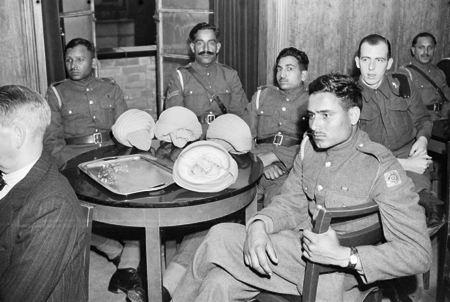
Private Mobed Shaffi of the Royal Indian Army Service Corps (RIASC) listens to the broadcast with some of his fellow soldiers around a table in the Hall of India, 1942
Eventually, when the first battle at Ypres turned into a siege, the sepoys were stationed in their own sector, south of the city. This stronghold accounted for around a third of the total 30-40 mile front line – a most significant contribution that would test each of them. Letters from Muslim sepoys still survive from nearly a century ago, and poignantly reveal their inner thoughts and fears. In May 1915 Subadar Muhammad Agia of the 57th Rifles wrote, “It is just like the grinding of corn in a mill; there is no counting the number of lives lost. Not a single British or native officer of the old regiment is left, and not one sepoy.”
Despite the daily horrors they endured, the British officers and Indian sepoys soon developed special bonds. British officers who led Indian regiments immersed themselves in the culture of India; learning to speak the same language, even eating the same food as the men they were leading. Major Corrigan explains, “The reason the British were better at running armies not of their race was because of the accommodations they made; unlike the French who would make recruits learn their language, the British Officer was expected to learn the language of his men. Urdu was the official language of the Indian Army at the time but they also had to learn regional dialects and have specialist knowledge of the religious needs of their men.”

An Indian Army soldier smoking a hookah at a camp in the New Forest in October, 1914
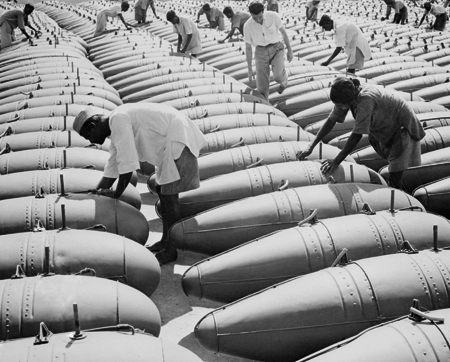
Indian workers carry out checks on a consignment of newly constructed 75 gallon auxiliary fuel tanks at the Hindustani Aircraft Factory in Bangalore, 1944
The conditions on the frontline made it hard to uphold the requirements of faith while on duty, although many Muslim soldiers struggled on and kept the fasts of Ramadan, gaining strength and solace from their faith. Stationed in France at the time of Eid in July 1917, Abdul Ali Khan wrote, “All of the Muslims of the Division had their prayers together and the assembly was close to our regiment. We, as far as possible, gave them food and tea. About 1,500 men assembled and prayers were offered for the victory of our King.”
From the frontline, some 12,000 injured Indian troops were sent for medical treatment to Brighton on the English south coast, where an army hospital was established in the famous Royal Pavilion during the First World War. Major Corrigan describes how the arrival of these men in Brighton was seen by the locals, most of whom had not seen a non-white man before. “Certainly there was no racism in the same sense that there is now,” he explains. “There was simply curiosity.” Muslim soldiers who died in Brighton were buried in a specially consecrated Muslim burial ground half a mile from Woking’s Shah Jahan Mosque constructed in 1889 as Britain’s first purpose-built mosque, and later they were moved to a military cemetery, where their named gravestones remain today.
While we cannot forget the individual men that gave their lives, the sheer numbers of Commonwealth troops involved in World War I and World War II are staggering. In all, over 161,000 Indian army soldiers were killed in the two World Wars according to the Commonwealth War Graves Commission. India’s army grew from 200,000 in 1939 to 2.5 million in 1945, with Muslims making up about 30-40% of the numbers at any one time, even though they were only about 22-25% of the Indian population.
And as Britain battled from the First World War to the Second, she became increasingly dependent on the Indian Army: the largest volunteer army in both World Wars, as men signed up to fight rather than being conscripted. In North Africa Indian soldiers were in the region of 100,000 troops, with five Indian divisions serving in that theatre of war. Out of the 50-60,000 troops serving in Italy the Muslim contingent was estimated to be up to 20,000. Three Indian divisions played a crucial role in the Italian Campaign and the 4th & 8th Indian divisions won numerous battle honours for their bravery and gallantry against the might of Nazi Germany.
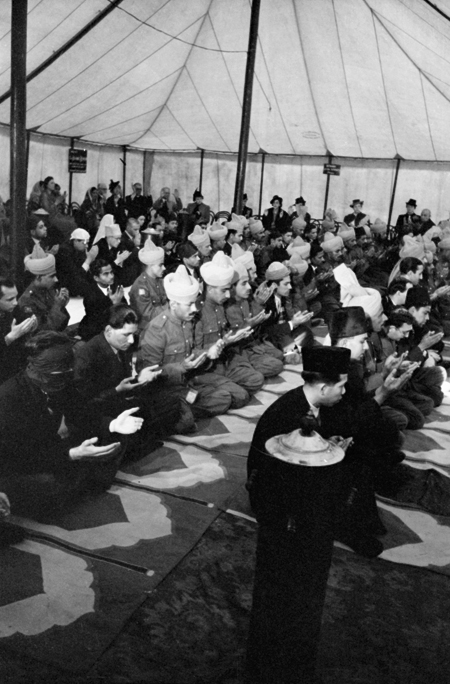
Muslims at prayer in a large tent which has been set up outside the Woking Mosque as part of the Eid ul Fitr celebrations. Included are men of the Royal Indian Army Service Corps, 1941
Jahan Mahmood, a community historian from Birmingham, focuses his study on 5,500 Indian army deaths in Italy. His work is fascinating because it breaks down Muslim casualties according to recruitment areas within British India, and then traces links between today’s British Pakistani communities and the areas where recruitment took place. The majority of Muslim recruits came from what is now Pakistan and Mahmood’s work will enable families within the British Muslim community to better understand their own histories, and to celebrate the contributions they have made to this country.
Of the 122 deaths of soldiers under the age of 18 in Italy, 90 were Muslim. Among them were three 15-year olds: Amir Khan from Attock, Gulab Khan from Rawalpindi, and Mian Khan from Kohat. One of them was a Lance Corporal, quite an achievement for a boy of his tender age. Jahan notes that Italy “was a very difficult campaign. The Indians, particularly the 8th Indian Division became known as the river-crossing division, and a Muslim Victoria Cross recipient in World War II, Ali Haidar, was commended especially because of this feat. They proved themselves great warriors, soldiers who followed orders unquestioningly. They were well known for their reckless bravery.”
The first Indian recipient of the Victoria Cross in World War I, Khudadad Khan stated, “To die on the battlefield is glory,” echoing the feeling amongst many Muslim soldiers that war brought the opportunity for heroism on the battlefield, and the chance to win honour. “We should be ashamed to go back till after we have won the victory,” wrote Dafadar Fazl Khan of the 18th Lancers in October 1916. The notion of izzat (honour) was one that was used to recruit Muslim men of the empire, and so important was the Muslim contribution in both World Wars that Churchill himself wrote, “We must not on any account break with the Muslims who represent 100 million people and the main army elements which we must rely on for the immediate fighting.”
Churchill’s sentiments were borne out by the statement of Field Marshall Sir Claude Auchinleck, a British army commander during World War II, “Britain couldn’t have come through both wars if they hadn’t the Indian army.” Britain has shared the experience of the World War I and II with Muslims from around the world, but this bond has been largely overlooked. Commonwealth soldiers played a role on the fields of Europe and in lesser-known campaigns across the globe: in Burma, Persia, and also Africa where troops were fighting in Libya, Tunisia, Egypt, Sudan and Somalia. These forgotten heroes were men of the empire who gave their lives and limbs in the name of duty. There was also the Palestine Regiment; and in World War II Arabs and Jews fought together under the British flag against Nazi Germany and Fascist Italy.
World Wars I and II connect every family in Britain. “If more was known about the contribution of so many Muslim soldiers of the British Indian Army, it might help to restore a sense of pride, and cement the social bonds of different communities in British society,” Jahan suggests. “This would turn the idea of a shared heritage into a meaningful weapon against prejudice.”
The recognition of a shared past has the potential to give us a sense of a shared future; a future not marred by war, but rather one of contributing to the common good. That is why this Remembrance Day we must honour all those who died, including the Muslims who gave their lives for the freedom of this country.
Propaganda
The Germans and Japanese recognised the immense worth of the British Indian army, bombarding them with propaganda in an attempt to weaken their resolve. Much of the propaganda was focused on portraying the British as the real enemy; manipulating images of Winston Churchill to resemble that of a tyrant. German and Japanese propaganda gave Britain the role of the ‘oppressor’, suggesting to colonised Indians that they were, in effect, enslaved by the British army. The British retaliated by issuing counter propaganda which, in WWII for instance, likened the Indian army to their own soldiers; boasting slogans of unity with a simple image of Caucasian army officials stood beside a South-Asian and an Afro-Caribbean entitled ‘Together’.
However, enemy propaganda was cleverly orchestrated; touching issues pertinent to Muslims such as burial and the afterlife. Playing on the developing nationalist issues amongst the Indian army, propaganda concerning land and ownership rights also began to surface developing tensions between the soldiers.
The Germans printed ‘brochure-like’ leaflets, documenting how much better life in German camps would be for Indian soldiers than on the frontline. Similarly, recognising the addition to manpower soldiers would bring, the Japanese created their own Indian National Army with prisoners they had captured, convincing Indian soldiers that they ought to be united in their ethnic minority against the ‘white master’.
The Indian troops were evidently perceived as a threat, occupying much of the enemy territory in North Africa, Italy and Burma. The mere fact that the Japanese and Germans thought it potent to issue propaganda specifically angled towards Muslims is telling of their immense contribution to the war effort.

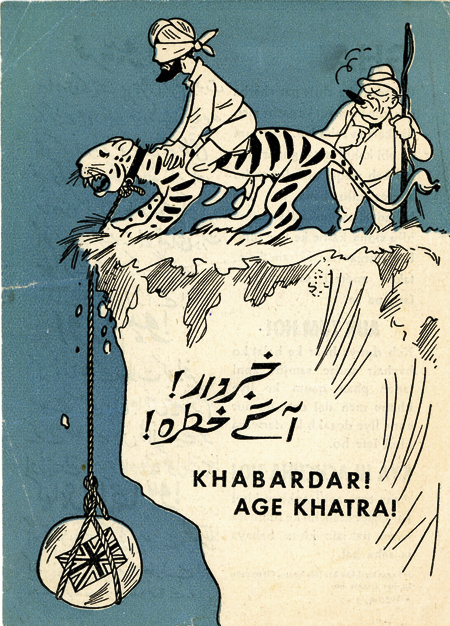
War Graves
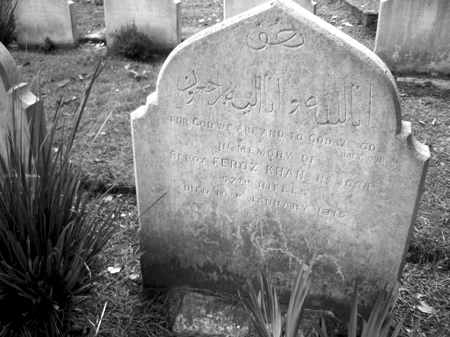
1.7 million men and women of the Commonwealth forces died during the two World Wars. There are 23,000 cemeteries, memorials and other locations worldwide where they are commemorated. When you search the name Muhammad on the Commonwealth War Graves Commission website, it states, “There are too many results, and the top 1001 is displayed.”
------------------------------------------------------------------
Medals of Honour
We select a number of high profile Muslim servicemen and women who were awarded decorated military honours for their dedication and relentless commitment to their detachment.
Burma - A Forgotten Battle
We hear from veteran brothers Mushtaq Ahmed and Abdul Salam about Britain’s forgotten battle– Burma – where 700,000 Indian soldiers were posted during the Second World War, out of a total Allied force of 1 million.
Acknowledging the Contribution
Political, Military and Religious leaders pay tribute to the sacrifices made by Muslims for Britain in the two world wars.
Show your support for the Muslim soldiers and campaign for a Muslim memorial.
Find out more> www.emel.com/campaign
Images - Imperial War Museum
Videography by Robi Chowdhury
Animation by Imran Ahmed of iGrafiks – www.iGrafiks.co.uk and www.steveanimates.com
Voiceover by Tufail Hussain
'Remember' - Soundtrack by Bruno Morisetti
Stock images courtesy of Said Adrus – Read more about the ‘Lost Pavillion’ exhibition here
For more details about Britain's Muslim Soldiers in WWI and WWII, visit www.britainsmuslimsoldiers.co.uk
Bookmark this |
|
Add to DIGG |
|
Add to del.icio.us |
|
Stumble this |
|
Share on Facebook |
|
Share this |
|
Send to a Friend |
|
Link to this |
|
Printer Friendly |
|
Print in plain text |
|





Comments
2 Comments
1
Building For The Future
13 Nov 11, 02:20
Thank you for this very important article
2
Building For The Future
13 Nov 11, 02:20
Thank you for this very important article